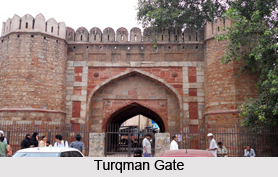 Turqman Gate, located to the southern edge of Shahjahanabad, is named after the Sufi Saint Hazrat Shah Turqman Bayabani. The saint resided in Delhi in the late 13th century. His 13th century tomb and dargah stand in the east direction. Turqman Gate is located in Delhi and is one of the twelve existing gates of the city. It is situated in the southern part of the old walled city, in front of the Ramleela Ground. It has a square plan with high arched openings. Turqman Gate is one of those monuments in the city that has been well kept.
Turqman Gate, located to the southern edge of Shahjahanabad, is named after the Sufi Saint Hazrat Shah Turqman Bayabani. The saint resided in Delhi in the late 13th century. His 13th century tomb and dargah stand in the east direction. Turqman Gate is located in Delhi and is one of the twelve existing gates of the city. It is situated in the southern part of the old walled city, in front of the Ramleela Ground. It has a square plan with high arched openings. Turqman Gate is one of those monuments in the city that has been well kept.
Turqman Gate is a solid, square shaped building made of red sandstone. The gates here have high arched openings. Turqman Gate is also called as "Turqman Darwaza" by the local people residing there. Thus, the gate standing in isolation in the middle of the modern towering buildings of busy Asaf Ali Road is one of the best historical places to visit in Delhi. It is easily reached by taking the Esplanade Road. The tomb of Razia Sultana and Kali Masjid/ Kalan Masjid are located in close proximity of the gate. The gate was the scene of Turqman gate demolition and rioting in 1976.
Turqman gate demolition and firing was an infamous case of political oppression and police brutality during the National Emergency when the police shot and killed people protesting against demolitions of their houses ordered by Indira Gandhi`s government in 1976.
During the National Emergency, Indira Gandhi`s government prompted by her son Sanjay launched the demolition drive to cleanse Delhi of slums and force poor residents to leave Delhi and move to distant settlements. The residents of Turqman Gate mostly Muslims refused to move as they would have to commute every day paying heavy bus fares to reach the city to earn their living. They resisted the bulldozing of their houses. On April 18, 1976, the police opened fire on protesters killing several of them. The government who had earlier imposed censorship ordered the newspapers not to report the massacre. Indian public came to know about killings through foreign media like BBC.



















